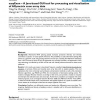90 search results - page 1 / 18 » Exon level integration of proteomics and microarray data |
BMCBI
2008
13 years 11 months ago
2008
Background: Previous studies comparing quantitative proteomics and microarray data have generally found poor correspondence between the two. We hypothesised that this might in par...
BMCBI
2008
13 years 11 months ago
2008
Background: Alternative RNA splicing greatly increases proteome diversity and thereby contribute to species- or tissue-specific functions. The possibility to study alternative spl...
BMCBI
2010
13 years 11 months ago
2010
Background: Genome-wide expression studies have developed exponentially in recent years as a result of extensive use of microarray technology. However, expression signals are typi...
BMCBI
2007
13 years 11 months ago
2007
Background: Regulation of gene expression is relevant to many areas of biology and medicine, in the study of treatments, diseases, and developmental stages. Microarrays can be use...
BMCBI
2008
13 years 11 months ago
2008
Background: Alternative splicing is a major contributor to the diversity of eukaryotic transcriptomes and proteomes. Currently, large scale detection of alternative splicing using...

